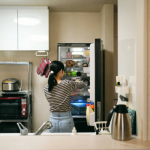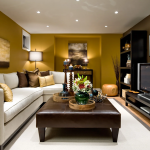The charm of a modern rustic house design lies in its unique ability to blend the simplicity of contemporary styles with the warmth and authenticity of rustic living. This design approach celebrates natural elements, from wood and stone to natural light, creating spaces that feel both sophisticated and homey. In this article, we’ll explore the key elements that make up modern rustic interiors, offering you a comprehensive guide to achieve the perfect balance between old-world charm and modern touches in your own home. Whether you’re crafting the floor plans for a new construction or revamping the living rooms of mountain homes with an eye for rustic charm, you’ll come away with ideas that will make your living spaces feel more inviting and chic.

Defining the Modern Rustic Aesthetic
At its core, the modern rustic aesthetic is about finding the perfect blend between streamlined modernity and the rich textures and warmth of rustic design. This eclectic fusion lets natural materials take center stage, while cleaner lines and modern conveniences ensure the living spaces meet contemporary standards of comfort. Home decor that incorporates elements such as exposed wooden beams, stone walls, and farmhouse artisan crafts harmonizes with sleek modern lines to create a distinctive and inviting interior.
Materials and Textures that Define Modern Rustic Homes
Material choice lies at the heart of the modern rustic design. Embracing earthy, raw components can anchor the home in the rustic tradition while the incorporation of modern elements keeps the styling contemporary.
Natural woods such as reclaimed pine or oak are staples for flooring, wall decor, and ceiling beams. Stone features large in the build, with features like natural stone fireplaces becoming a cozy focal point. Meanwhile, the clever use of iron and steel can add a sleek edge to the overall look.
| Material | Uses in Modern Rustic Design |
|---|---|
| Reclaimed Wood | Flooring, Accent Walls, Ceiling Beams |
| Natural Stone | Fireplaces, Kitchen Backsplashes, Exterior Accents |
| Iron & Steel | Stair Railings, Light Fixtures, Furniture Frames |
| Natural Fabrics | Upholstery, Window Treatments, Area Rugs |
Architectural Elements of Modern Rustic Design
The architecture of modern rustic homes often features large open spaces that not only provide stunning visual impact but also promote a social, inviting environment. The use of large windows blurs the line between indoor and outdoor spaces, allowing natural light to flood the interiors and showcase the natural beauty around the house. Vaulted ceilings with exposed beams can add drama and a sense of expansiveness to the rooms.

Modern Rustic Interiors: A Synthesis of Old and New
Creating an interior that feels coherent and balanced is key in modern rustic design. Furnishings with clean lines can still have rustic vibe if made from natural woods and placed against the backdrop of a stone accent wall. Conversely, more rustic furniture pieces can be modernized with the addition of contemporary fabric or a coat of crisp, white paint.
Sustainable Practices in Modern Rustic Design
Sustainability is a common thread in modern rustic home design. Many homeowners want to ensure their living spaces not only look good but also have minimal environmental impact. Energy-efficient appliances, eco-friendly materials, and designs that reduce waste are all pillars of this approach.
Lighting and Ambience in Modern Rustic Homes
When it comes to lighting, modern rustic homes are often lit to complement the natural light that streams in through large windows and doors. A mix of overhead, task, and ambient lighting enhances the cozy yet sleek atmosphere.
Landscaping and Outdoor Living in Modern Rustic Homes
The connection with nature remains a fundamental aspect of living in a modern rustic home. The outdoor spaces are thoughtfully designed to be extensions of the interior, featuring elements like wooden patios, stone pathways, and rustic landscaping that play off the house’s aesthetic.

Conclusion
Modern rustic house design successfully brings together the old-world appeal of rustic charm with the sleekness of modern touches. It is a versatile and timeless style that caters to comfort and aesthetic beauty. Natural materials play a significant role, not just in the architectural features but also in the decor. Whether it’s incorporating a wooden dining table with contemporary chairs in the kitchen or adding cozy textures to a minimalist bedroom, the modern rustic design is about crafting spaces that feel lived-in and loved, without forgoing modern functionality and style.
FAQs
Q1: What distinguishes modern rustic design from traditional rustic style?
A1: Modern rustic design combines the cozy feel of traditional rustic decor with streamlined modern elements creating a lighter and more open space while emphasizing natural materials and textures.
Q2: How can I make a modern rustic home feel cozy without looking outdated?
A2: Balancing rustic elements like wood floors or exposed beams with contemporary furniture, adding soft lighting, and layering textures can create a cozy feel without an outdated look.
Q3: What are the best materials to use in a modern rustic design?
A3: Reclaimed wood, stone, natural fabrics, and metals are some of the best materials for creating an authentic modern rustic look.
Q4: Can modern rustic design include color, or does it have to be neutral?
A4: While neutral colors are standard in modern rustic design for their soothing effect, you can add color through accent pieces in earthy or muted tones to bring warmth and variety.
Q5: How important is sustainability in modern rustic design?
A5: Sustainability is often integral to modern rustic design, with a focus on using eco-friendly materials, renewable resources, and incorporating energy-efficient features.


